financial modelling training
Merchandising Financial Training

初始毛利
16.67% 9.09% 18.37% #DIV/0! 528.57% 13.04% 5.26% 54.20% 19.35% 15.79% 808.33% 13.33% -1400.00% 4.76% 4.76% 29.26%
Initial Margin 初始毛利
Q&A
Markdown 降价
Objective 目的
To help you Learn basic retail math and measures used at Wal-Mart Practice and apply basic retail math calculations Be a better business person and a better merchant Learn how to use financial information to help with strategic planning, limiting a reactionary approach Understand how you actions influence the profit components 帮助你 了解在沃尔玛所使用的基本零售数学和评估方法 练习和运用基本零售数学的计算方法 成为一个成功的商人 通过使用这些财务信息来帮助到我们的战略计划,减少负面影响 明白如何通过行动来影响利润指标
•5845 # G.O. Date: 5/18/2005
Non-Comp Store
Sales 销售
•What’s the Comp Store after May 1st, 2006?
•2006年5月1日之后,什么叫作可比较商店? •May 1st date for conversion of 13th Month Comp. Starting May 1st comp will change monthly based on the open date. •从2006年5月1日开始,一家商场只要开业满13个月就会被 列入可比较商店,并且每月更新一次。也就是说,每个月 的可比较商店会不同。 •For example 例如:
金融理财培训PPT模板课件

单击添加页面标题
标题内容
请在此处添加文本内容
□
标题内容
请在此处添加文本内容
标题内容
请在此处添加文本内容
标题内容
请在此处添加文本内容
单击添加页面标题
4
3
2
1
0
2
4
6
8
10
12
14
请在此处添加文本内容
请在此处添加文本内容
凭借自身优势和专业化的独特视角为 客户提供优质的PPT服务 请在此处添加文本内容
21
单击添加页面标题
标题内容
01
请在此处添加文本内容
标题内容
03
请在此处添加文本内容
标题内容
05
请在此处添加文本内容
标题内容
02
请在此处添加文本内容
标题内容
04
请在此处添加文本内容
标题内容
06
请在此处添加文本内容
单击添加页面标题
01
标题内容
请在此处添加文本内容
02
标题内容
请在此处添加文本内容
03
04 添加目录标题 CLICK TO ADD CAPTION TEXT
2
添加目录标题
Lorem Ipsum is simply dummy text of the printing and typesetting industry. Lorem Ipsum has been the industry's standard dummy text ever since Lorem Ipsum is simply dummy text of the printing and typesetting industry
财务建模实验报告

财务建模实验报告1. 引言本实验旨在通过运用财务建模工具,对特定企业的财务情况进行分析和预测。
通过构建财务模型,可以更加全面地了解企业的财务状况,并且预测未来的财务表现。
本报告将介绍财务建模的基本概念和步骤,并通过一个实际案例进行详细说明。
2. 财务建模概述财务建模是指利用财务数据和统计方法,建立一种描述和预测企业财务状况和表现的模型。
通过财务建模,可以对企业的财务数据进行分析、比较和预测,从而帮助企业做出更加准确的经营决策。
财务建模的步骤通常包括以下几个方面:2.1 数据准备和整理财务建模的第一步是收集企业的财务数据,并进行整理和准备。
这包括收集和整理企业的资产负债表、利润表和现金流量表等财务报表,以及其他相关的财务数据。
2.2 建立模型在数据准备和整理完成后,可以开始建立财务模型。
财务模型通常基于财务数据和统计方法,可以是基于Excel的电子表格模型,也可以是使用专门的财务建模软件开发的模型。
2.3 模型验证和调整建立财务模型后,需要对其进行验证和调整。
这包括对模型的输入数据和计算过程进行检查,确保模型的准确性和可靠性。
如果发现模型存在问题,需要进行相应的调整和修正。
2.4 模型应用和分析模型验证和调整完成后,可以将财务模型应用于具体的分析和预测工作中。
通过对模型的应用和分析,可以得出对企业财务状况和表现的更加准确的结论,并为企业的经营决策提供支持和指导。
3. 案例分析在本实验中,我们选择了一家假想的制造业公司进行财务建模和分析。
该公司的财务数据包括资产负债表、利润表和现金流量表等。
3.1 数据准备和整理首先,我们收集了该公司最近三年的财务报表数据,并对其进行整理和准备。
我们将数据输入到Excel电子表格中,并按照财务报表的格式进行组织。
3.2 建立模型基于准备好的数据,我们开始建立财务模型。
我们使用Excel电子表格软件,按照财务报表的结构和计算公式,构建了资产负债表、利润表和现金流量表的模型。
FINC6019_Financial Modelling_2010 Semester 1_FINC6019_Financial Modelling_UoSOutline

FINC6019Financial ModelingSemester 1, 2010 Unit of Study OutlineCoordinator: Mr. Hamish MallochPhone: 02 9036 6273,Email:hamish.malloch@.auOffice:Merewether, Room 458Consultation Times:Thursday 4-5 pm. Other times by appointment (e-mail preferred).Classes:Time:Wednesdays 6-9 pm Venue:Carslaw Room 2511.Unit of study information1.1.Faculty Handbook descriptionIt is important for practitioners of finance, at all levels, to be able to evaluate the applicability of a range of models for a given problem and to effectively implement and use the model that is selected. This unit will present methods for model design, implementation and evaluation in the context two fundamental financial models; the discounted cash flow valuation model and the portfolio selection model. Spreadsheet engineering methods for designing, building, and testing spreadsheet models and for performing model-based analysis will be presented. There will be a concise coverage of optimization, sensitivity analysis and simulation featuring a strong spreadsheet orientation and a modelling emphasis.1.2.Aims and contextThe aims of this unit are for students to develop a deeper understanding of financial models, specifically corporate valuation, portfolio and options pricing models. The students will also obtain an understanding of good model design, model implementation and spreadsheet engineering skills, issues with financial data and its impact on the modelling procedure, and the use of techniques such as simulation to test and validate models. Emphasis throughout the course will also be placed on the appropriateness of models used.2.Learning outcomes, learning and teaching activities & assessment2.1.Intended learning outcomesAt the end of this course the student will be able to:∙Apply the principles of model building and implementation to solve problems related to corporate valuation, portfolio construction and options pricing.∙Ascertain the appropriateness of a particular model for its application.∙Understand and be able to deal with issues pertaining to the use of financial data.∙Develop spreadsheet skills.∙Work effectively in a group environment.2.2. Learning and teaching activitiesClass sessions will typically involve a 2-hour lecture followed by a 1-hour workshop/tutorial session. The lectures will introduce and explain the material and highlight important concepts. You are expected to have made a serious attempt at all workshop questions prior to classes and participation in class discussions is encouraged. You may find some of the workshop questions quite challenging. Struggling with this challenge is a necessary part of gaining real understanding.Required text:“Financial Modeling” (3rd edition) by Simon Benninga. Published 2008 by MIT Press.It is important that the 3rd edition is used as older editions will not be up to date with features of excel and finance theory.Recommended texts (purchase not required):“Valuation: The Art and Science of Corporate Investment Decisions” by Sheridan Titman and John D. Martin. Published 2008 by Pearson-Addison Wesley.“Principles of Finance with Excel” by Simon Benninga. Published 2006 by MIT Press.“Excel Modeling and Estimation in Corporate Finance” (3rd Edition) by Craig W. Holden. Published 2009 by Pearson-Prentice-Hall.“Options, Futures and Other Derivatives” (4th Edition) by John Hull, Published 2000 by Prentice Hall.2.3. AssessmentWorkshop questions will be posted on Blackboard prior to class. Questions will be related to the previous weeks lecture. It is important to attempt questions before class – solutions and feedback will be provided in labs.2.4. Assessment detailsThere are three assessments in this subject:∙ A laboratory exam covering the modelling of free cash flows and portfolio construction from the first 6 weeks of the course. This will take place in the laboratory after the lecture in teaching week7. Students will be required to submit their spreadsheets for marking electronically.∙ A group assignment covering material from the second half of the course which is to be completed by the end of semester. Students are to form groups of 4-5. Material covered will include options valuation, portfolio construction and simulation.∙The final exam covers all material in the course. It will be based around theory and some numerical analysis learned throughout the course.2.5. Workload and minimum requirementsAcademic Board guidelines state that one credit point equates to approximately 1.5 to 2 hours of student effort per week for a typical 13 week semester. This means that if you are an average student seeking to get an average result for this unit then you should plan to spend at least 9 hours each week on learning. The minimum requirement for completion of the unit is to attempt all assessable activities and achieve a pass grade overall.Criteria for the overall assessment and your final total grade for the course:PASS – Demonstrate knowledge and understanding of facts and principles. Be able to apply concepts and principles in new situations.CREDIT – All criteria for a pass in course, plus: demonstrate analytical skills, that is be able to distinguish, classify and relate the assumptions, hypotheses, evidence, or structure of statements and questions within the framework of the subject matter.DISTINCTION – All criteria for a credit plus: demonstrate the ability to originate, integrate and combine ideas into work that constructs a unique view of the subject matter.HIGH DISTINCTION – All criteria for a distinction, plus: students show the ability to appraise, assess or critique ideas and evidence in the subject area using reasoned judgement against articulated standards.2.6. FeedbackStudents will receive feedback on all assessments before the final exam. Suggested answers to the laboratory presentation and group assignment will be placed on Blackboard. General feedback regardingcourse content and other student queries will be provided in lectures. Students are strongly encouraged to use the discussion forum on Blackboard to correspond with the lecturer and each other. This will be checked regularly. Consultation with the lecturer is also available at the allotted time or by appointment.2.7. Academic honesty, plagiarism, legitimate cooperation and group workCommencing students should complete the academic honesty module available via Blackboard before their first assessment submission. Students should refer to Faculty and University policies on academic dishonesty and plagiarism(.au/business/currentstudents/student_information/student_administration_manual), copyright .au/senate/policies/Intellectual_Property_Rule.pdf and the …All your own wo rk website‟ (.au/secretariat/students/plagiarism_index.shtml) for information about legitimate cooperation, group work, how to reference correctly and how to avoid plagiarism.Academic honesty is important to protect students' right to receive due credit for work submitted for assessment. It is clearly unfair for students to submit work for assessment that dishonestly represents the work of others as their own and gain marks and degrees, which are not based on their own efforts and abilities. Deliberate breaches of academic honesty constitute academic misconduct. These breaches include: plagiarism, fabrication of data, recycling previously submitted material, engaging someone else to complete an assessment on one‟s behalf and misconduct during supervised assessments.The penalties for academic misconduct may include: a mark of zero on the assessment; a fail grade in the unit of study, additional assessment (including an unseen exam), and reference of the matter to the University Registrar.All assessments will be checked for plagiarism. Where plagiarism is suspected, the assessment will be fully checked and monitored using manual process, google checks and also electronic plagiarism detectors. In order to do this, the Faculty may reproduce the assessment, provide a copy to another member of faculty, and/or communicate a copy of this assignment to a plagiarism checking service (which may then retain a copy of the assignment on its database for the purpose of future plagiarism checking).Academic dishonesty involves more than just copying material. Cooperation and helping other students may at times trigger academic dishonesty proceedings if it appears you have worked too closely with another studentIndividual assignments must be written and prepared alone. You may consult with other students about ideas and possible research sources but the analysis and writing of the assignment must be done alone. Group assignments should be prepared within the group. Students should contribute fully to the group and take part in all group activities, contributing ideas, analysis and writing to the final product. While students within the group should assist each other freely, students should not carry this level of cooperation out side the group. One group may cooperation and help another group about ideas and possible research sources but the analysis and writing of the assignment must be done by the group alone.3.Student feedback and evaluation3.1 Feedback received from previous studentsStudent feedback from previous semesters included more emphasis on electronic learning and more practical problems to be attempted in workshops. Students also requested less overlapping material with other finance subjects – and more focus on the role of financial analysts. Students also requested earlier posting of lecture notes and additional reading material on blackboard.3.2 Improvements madeLecture notes will now be posted at least one day prior to the lecture. There will be less focus on theory already covered in other finance subjects and more on applied techniques.3.3 Collection of feedback from current studentsFeedback will be collected via a Unit of Study Evaluation form at the end of the semester. Students may contact the lecturer with any concerns or suggestions for improvement throughout the semester (e-mail preferred).4.University policies and servicesAll students must comply with and follow all Faculty and University policies and procedures.Faculty policies are contained in the Administration Manual for Students at.au/business/currentstudents/student_information/student_administration_manual. It is crucial that you take the time to consult this manual early in your studies in order to familiariseyourself with policies and procedures relating to critical issues such as the Faculty‟s policy on sp ecial consideration (including requirements and timelines. e.g. lodging applications five working days after a missed assessment), appeals (lodge within 15 working days of the decision) and other policies such as enrolment, credit etc. Assistance is availa ble from the Faculty‟s Student Information Office at.au/business/student_information_officeUniversity policies at .au/policy Assistance is available from the University‟s Student Centre .au/current_students/student_administration/or the Student Affairs Unit.The code of conduct is an important policy which outlines the University‟s expectations about treating all staff employees and students with respect, dignity, impartiality, courtesy and sensitivity and refrain from acts of discrimination, harassment or bullying..au/ab/policies/Student_code_conduct.pdfLinks to other student services and resources are included on Blackboard and on the Faculty‟s Learning and Teaching website .au/business/learning.5.Topic and assessment scheduleFM: Benninga, Simon (2008) Financial Modeling, 3rd Edition, MIT Press, Cambridge, M.A.。
英国留学国际金融专业
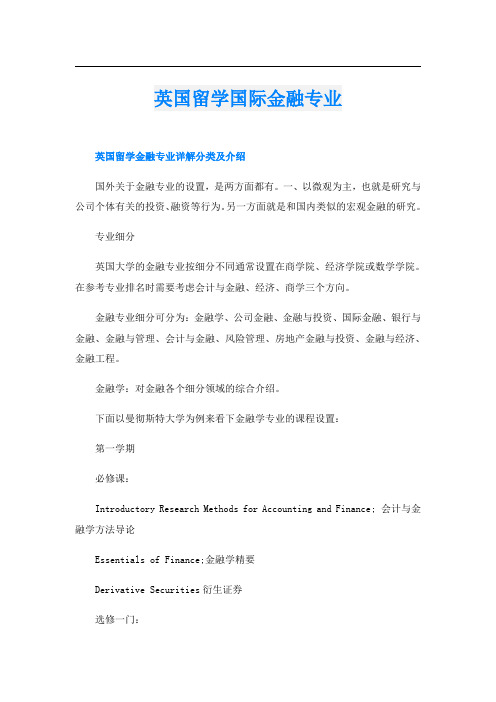
英国留学国际金融专业英国留学金融专业详解分类及介绍国外关于金融专业的设置,是两方面都有。
一、以微观为主,也就是研究与公司个体有关的投资、融资等行为。
另一方面就是和国内类似的宏观金融的研究。
专业细分英国大学的金融专业按细分不同通常设置在商学院、经济学院或数学学院。
在参考专业排名时需要考虑会计与金融、经济、商学三个方向。
金融专业细分可分为:金融学、公司金融、金融与投资、国际金融、银行与金融、金融与管理、会计与金融、风险管理、房地产金融与投资、金融与经济、金融工程。
金融学:对金融各个细分领域的综合介绍。
下面以曼彻斯特大学为例来看下金融学专业的课程设置:第一学期必修课:Introductory Research Methods for Accounting and Finance; 会计与金融学方法导论Essentials of Finance;金融学精要Derivative Securities衍生证券选修一门:Portfolio Investment证券投资International Macroeconomics and Global Capital Markets国际宏观经济学与全球资本市场Foundations of Finance Theory金融学基础第二学期Financial Econometrics金融计量经济学Advanced Empirical Finance高级实证金融学Corporate Finance; 公司金融选修一门International Finance国际金融Financial Statement Analysis财务报表分析Real Options in Corporate Finance公司金融中的实物期权Mergers and Acquisitions: Economic and Financial Aspects关于企业并购的经济金融思考Dissertation毕业论文公司金融:解决以公司财务、公司融资、公司治理为核心的公司治理结构方面的问题,综合运用各种形式的金融工具与方法,进行风险管理和财富创造。
上海财大财务模型建立 Financial Modeling培训课程

您不得不参加的课程:
Ø Ø Ø Ø 丰富的财务模型和案例讲解,涵盖企业管理的方方面面 深入学习经典财务模型如杜邦分析模型,帮助解决企业一般决策问题 掌握产品毛利分析、企业管理仪表板等财务分析模型,并运用于实际工作中 了解“天才”布莱克-斯科尔斯模型及其他特殊的财务模型,认识这些模型在金融和企 业财务领域中的突出作用
时间和地点:
开课 时间和地点 时间 地点 开课时间(2011 年) 10 月 24-25 上海
上海财经大学 MBA 学院 EDP 中心
中国财务培训第一品牌 报名及汇款方式:
l 在线申请。请登陆上海财经大学教育培训网站,选定您想要申请的课程,点击在线申请 即可进行课程申请。 l 以传真或电邮的方式递交课程申请表。您可以致电销售人员索取课程申请表。
用 EXCEL 解决复杂的公司财务问题——复杂的理论也可以轻松实践
l l l 用 Excel 的矩阵函数和模拟运算表解决投资组合问题 讲解企业管理仪表板模型和企业发展战略与目标的调整 介绍二项式期权定价模型和它在 Excel 中的实施, 以及用 Excel 模拟对数正态分布 的定价处理 l 讨论布莱克-斯科尔斯欧洲式看涨期权和看跌期权的定价公式, 以及莱克-斯科尔斯 模型的应用——投资组合保险和实物期权 l l 用多项式建立近似的期限结构模型 用 Markov 过程和大量违约概率及债券回收率的信息建立有风险的公司债券的期望 回报率模型 l 长期国债期货合约中久期与交割最便宜的债院 EDP 中心
中国财务培训第一品牌
Ø Ø Ø Ø 公司财务总监、财务经理 总帐会计、成本分析、财务分析、项目分析等财务人员 研发人员 投行人员、金融从业人员
课程费用:
公开课课程为期2天,培训费用为4500元人民币,包括授课费用、内部资料费用和午餐茶 歇费用。
financial modeling pdf

financial modeling pdfFinancial modeling is a critical skill that allows finance professionals to create financial forecast models used in the decision-making process. These models help managers to make informed decisions by providing a clear picture of the financial health of the company. Financial modeling can be an overwhelming task, but it becomes easier when using a financial modeling PDF.A financial modeling PDF is a comprehensive guide that provides step-by-step instructions on how to create a financial model. The guide is designed for both beginners and advanced financial modelers looking to enhance theirfinancial modeling skills. The PDF is compiled by finance professionals who have years of experience in financial modeling, ensuring that the content is reliable and accurate.The financial modeling PDF is structured in a way that makes it easy to follow. The guide is divided into different sections, with each section covering a specific aspect of financial modeling. The sections are arranged in a logical order, ensuring that you first master the basics before moving to more complex tasks.Some of the sections covered in the financial modeling PDF include financial statement analysis, cash flow forecasting, valuation techniques, and sensitivity analysis. Each section provides detailed explanations, examples, and practical exercises to help you master the concepts. The exercises allow you to apply what you have learned in real-life scenarios, enhancing your understanding of financialmodeling.The financial modeling PDF also covers differentmodeling techniques, including the historical method, forecasting, regression analysis, and Monte Carlo simulations. These techniques are explained in detail, making it easy for you to choose the most appropriate technique for yourspecific financial modeling needs.Another benefit of using a financial modeling PDF isthat it provides you with a reference guide that you can access anytime, anywhere. You can save the PDF on your phone, tablet, or computer, allowing you to refer to it whenever you need to refresh your memory or clarify a concept.In summary, financial modeling is a critical skill thatall finance professionals must possess. The use of afinancial modeling PDF can make the financial modelingprocess less daunting by providing a structured guide that covers all aspects of financial modeling. The guide is designed to be easy to follow, and it's divided into sections that cover different aspects of financial modeling, making it easier to master the concepts. The financial modeling PDF isa valuable reference guide that you can access anytime, anywhere.。
FINANCIAL MODELLING (5)

Seek
final managerial and possibly board approval
Addressing the Possibility of Decision Bias
Project analysis team may be biased if they have incentives to get deals approved The strategic planning committee (investment proposal reviewers) should play the role of a sceptical boss – removing potential biases from the analysis Individuals with their own project ideas may be biased in favour of the project
Discounted Cash Flow (DCF) Analysis is widely used in industry.
M&A Valuations Equity
Analysts
Bringing Theory of Other Courses in a more practical setting.
Considering Investment?
The following five slides contain a few general principles of valuation We need to consider the purpose of the financial models that we construct
FINANCIAL MODELLING (13)

Balance Sheet Analysis (cont’d)
PPG : N et Pl ant , Pr o p er t y and Eq ui p ment t o Sal es
60%
55%
50%
45%
40%
35%
30% 1991 1992 1993 1994 1995 1996 1997 1998 1999 2000
PPG Corporation
PPG was established in 1883. It has paid a dividend continuously for more than 103 years In 2000, PPG had sales of $8.6 billion and profits of $620 million. The company has more than 35,000 employees.
The model for PPG
Firstly a useful property for Excel spreadsheets is that individual cells can be “named” and then the “name” of the cell be referred to in the formula. With any cell selected, you click in the box in the top left (directly above column A), and name the cell. You can then refer to the cell by name in the formula or by standard reference (e.g. B4) Note that referring to the Cell by name is an absolute cell reference (filling down or across will retain the reference to the named cell.
cfa 实践技能模块 financial modeling-概述说明以及解释
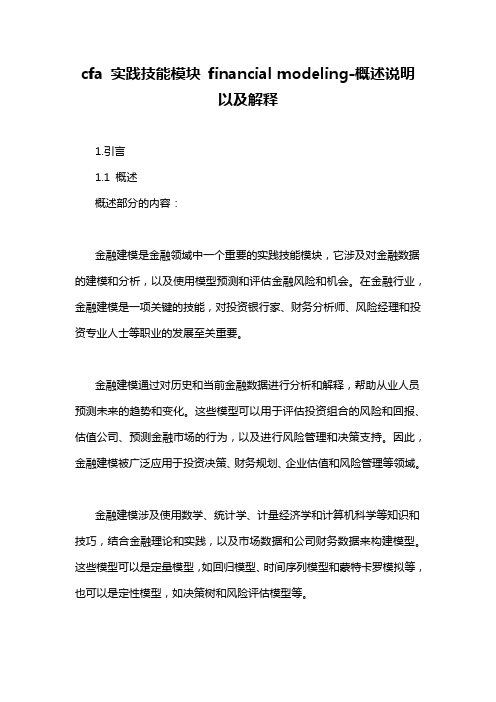
cfa 实践技能模块financial modeling-概述说明以及解释1.引言1.1 概述概述部分的内容:金融建模是金融领域中一个重要的实践技能模块,它涉及对金融数据的建模和分析,以及使用模型预测和评估金融风险和机会。
在金融行业,金融建模是一项关键的技能,对投资银行家、财务分析师、风险经理和投资专业人士等职业的发展至关重要。
金融建模通过对历史和当前金融数据进行分析和解释,帮助从业人员预测未来的趋势和变化。
这些模型可以用于评估投资组合的风险和回报、估值公司、预测金融市场的行为,以及进行风险管理和决策支持。
因此,金融建模被广泛应用于投资决策、财务规划、企业估值和风险管理等领域。
金融建模涉及使用数学、统计学、计量经济学和计算机科学等知识和技巧,结合金融理论和实践,以及市场数据和公司财务数据来构建模型。
这些模型可以是定量模型,如回归模型、时间序列模型和蒙特卡罗模拟等,也可以是定性模型,如决策树和风险评估模型等。
对于金融从业人员来说,掌握金融建模技能是至关重要的。
它不仅可以提高工作效率和准确性,还可以帮助从业人员更好地理解金融市场和公司的运作,以及预测金融趋势和风险。
此外,金融建模还能够提供有关投资决策和风险管理的量化参考,帮助从业人员做出更明智的金融决策。
本文主要围绕CFA实践技能模块中的金融建模展开探讨。
我们将深入研究金融建模的基本概念、方法和应用,并探讨金融建模在投资决策、风险管理和企业估值等方面的重要性。
通过对金融建模的全面理解和应用,我们将帮助读者更好地掌握这个核心技能,并在金融领域取得更好的业绩和发展。
1.2 文章结构文章结构决定了文章的整体框架和组织方式。
本文按照如下结构展开:第一部分是引言部分,包括概述、文章结构和目的。
引言部分通过概述来引导读者对实践技能模块financial modeling的重要性有基本的认识。
接着,文章介绍了本文的结构,即接下来会分为正文和结论两个部分,旨在全面、系统地探讨该主题。
金融类英语bert预训练模型
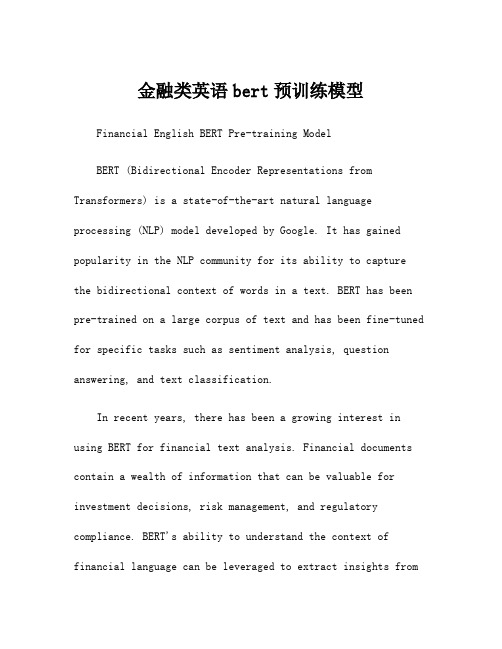
金融类英语bert预训练模型Financial English BERT Pre-training ModelBERT (Bidirectional Encoder Representations from Transformers) is a state-of-the-art natural language processing (NLP) model developed by Google. It has gained popularity in the NLP community for its ability to capture the bidirectional context of words in a text. BERT has been pre-trained on a large corpus of text and has been fine-tuned for specific tasks such as sentiment analysis, question answering, and text classification.In recent years, there has been a growing interest in using BERT for financial text analysis. Financial documents contain a wealth of information that can be valuable for investment decisions, risk management, and regulatory compliance. BERT's ability to understand the context of financial language can be leveraged to extract insights fromfinancial reports, news articles, social media posts, and other sources of financial information.One of the key challenges in financial text analysis is the complexity and ambiguity of financial language. Financial documents often contain specialized terminology, jargon, and abbreviations that may not be familiar to the general public. BERT's pre-training on a large corpus of text allows it to capture the nuances of financial language and generate accurate representations of financial texts.Using BERT for financial text analysis can help automate tasks such as financial statement analysis, sentiment analysis of financial news, and identification of financial market trends. By leveraging BERT's language understanding capabilities, financial analysts can efficiently process large volumes of financial text and extract valuable insights for decision making.In addition to its applications in financial text analysis, BERT can also be used for financial document classification, entity recognition, and event extraction. These tasks are essential for regulatory compliance, risk management, and investment research. By using BERT to automate these tasks, financial institutions can improvetheir operational efficiency and reduce the risk of errors in processing financial documents.Furthermore, BERT can be used to develop chatbots and virtual assistants for customer support and financial advisory services. By training BERT on a corpus of customer queries and financial advice, financial institutions can provide personalized and accurate responses to customer inquiries, improving the overall customer experience.One of the current challenges in using BERT for financial text analysis is the need for specialized financial training data. While BERT has been pre-trained on a large corpus ofgeneral text, there is a need for domain-specific training data to fine-tune BERT for financial language understanding. Financial institutions and research organizations can address this challenge by creating and sharing specialized financial training datasets, which can be used to pre-train BERT for financial text analysis.Another challenge is the need to ensure the accuracy and fairness of BERT's predictions in the context of financial decision making. BERT, like other machine learning models, can learn biases from the training data, which may lead to inaccurate or unfair predictions. Financial institutions and research organizations can address this challenge bycarefully curating the training data and monitoring the performance of BERT in real-world financial applications.In conclusion, BERT has the potential to revolutionize financial text analysis by capturing the nuances of financial language and extracting valuable insights from financialdocuments. By leveraging BERT's language understanding capabilities, financial institutions can automate tasks such as financial statement analysis, sentiment analysis of financial news, and regulatory compliance. With the development of specialized financial training data andcareful monitoring of BERT's performance, the use of BERT for financial text analysis has the potential to improve operational efficiency, decision making, and customer experience in the financial industry.。
非财务经理的财务训练营

二、财务报表阅读与分析
• • • • • • •
• • • •
财务报表综合解读: 综合运用财务信息透视 公司运作水平 实战演练:杜邦财务分析 综合分析:怎样产生理想的投资回报? 案例分析:分析某上市公司的财务状况,并 做出整体评价
财务的目标和角色 会计报表的构成 资产负债表、损益表的阅读和分析 资金流量和资金流量表的阅读和分析 会计报表之间的关系 如何从会计报表读懂企业经营状况, 评价公 司经营运作与风险 从管理的角度解读利润表
第4天 成本控制
十、企业面临的成本挑战
• • • • •
存货管理 案例分析:企业成本消减的几种经典方法
市场与内部运营管理的挑战 红海战略——生产领先型公司的核心竞争 力 三种有效改善成本的组织模式
十二、管理者的成本控制
• • • • • •
企业成本模式与竞争优势 如何决策适合本公司的成本模式和成本结 构 案例分析:规模效益与销售定价 综合分析:提高利润的方法 系统的成本分解——各部门通过那些环节 影响公司成本 成本控制关键点
十一、成本分析与控制
• • • • •
产品成本的概念和构成 CVP(本-量-利)分析与运用 如何运用目标成本法控制产品成本, 保证利 润水平 如何运用 ABC 作业成本法进行管理分析, 实 施精细成本管理 如何针对沉没成本和机会成本进行正确决 策
第5天 业务开拓中的财务管理
十三、销售增长的财务问题分析
•
客户风险评估
• • • • •
客户资信管理 识别客户风险的方法 应收帐款管理 应收账款管理制度与流程 应收账款管理关键指标
•
案例分析:失败的长虹
电话:021-60837966
中国上海市共和路 268 号企业广场 18 楼 传真:021-60837901 邮箱:service@
Financial Modelling

©2006 Deloitte Touche Tohmatsu CPA Limited. All rights reserved.
12
模式 2: 共同比财务报表
根据 Vitex Corp 1999至2002 年相应的历史报表中建立共同比 收益表和资产负债表,然后计算各项四年的平均销售额百分比。
©2006 Deloitte Touche Tohmatsu CPA Limited. All rights reserved.
9
•
A1 and R1C1 reference styles A1和R1C1的索引模式
• •
Tools ⇒ Options ⇒ General Seldom use
•
Using comments in cells 在单元格中插入批注
•
Insert ⇒ Comment Independent and dependent variables 独立变数与因变数 (Input and output variables 输入和输出变数) Date ⇒ Table Can only change the entire 只可整体修改 Hide numbers 隐藏数字: Format ⇒ Cells ⇒ Custom ⇒ “;”
•
Data table 模拟运算表
•Hale Waihona Puke • • ••Scenario manager 方案管理器
• •
Tools ⇒ Scenarios ⇒ Add ⇒ Scenario Values Tools ⇒ Scenarios ⇒ Summary
©2006 Deloitte Touche Tohmatsu CPA Limited. All rights reserved.
financial modeling prep介绍 -回复
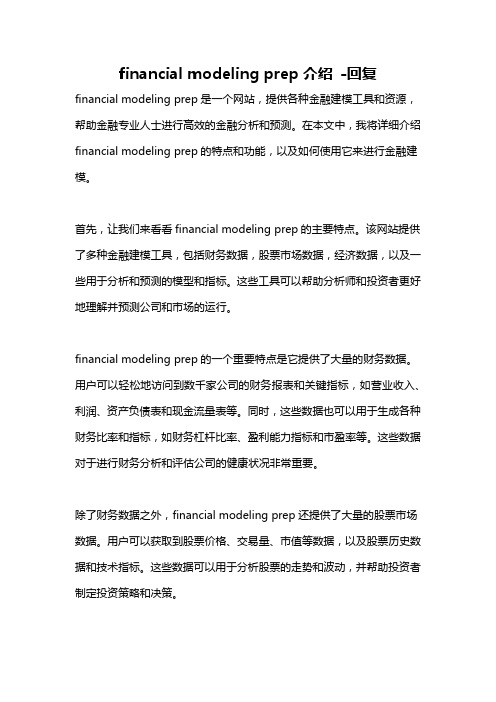
financial modeling prep介绍-回复financial modeling prep是一个网站,提供各种金融建模工具和资源,帮助金融专业人士进行高效的金融分析和预测。
在本文中,我将详细介绍financial modeling prep的特点和功能,以及如何使用它来进行金融建模。
首先,让我们来看看financial modeling prep的主要特点。
该网站提供了多种金融建模工具,包括财务数据,股票市场数据,经济数据,以及一些用于分析和预测的模型和指标。
这些工具可以帮助分析师和投资者更好地理解并预测公司和市场的运行。
financial modeling prep的一个重要特点是它提供了大量的财务数据。
用户可以轻松地访问到数千家公司的财务报表和关键指标,如营业收入、利润、资产负债表和现金流量表等。
同时,这些数据也可以用于生成各种财务比率和指标,如财务杠杆比率、盈利能力指标和市盈率等。
这些数据对于进行财务分析和评估公司的健康状况非常重要。
除了财务数据之外,financial modeling prep还提供了大量的股票市场数据。
用户可以获取到股票价格、交易量、市值等数据,以及股票历史数据和技术指标。
这些数据可以用于分析股票的走势和波动,并帮助投资者制定投资策略和决策。
金融建模中经济数据的重要性不言而喻,financial modeling prep也考虑到了这一点。
该网站提供了各种宏观和微观经济数据,比如国内生产总值(GDP)、通货膨胀率、利率等,这些数据对于预测市场走势和经济环境非常有帮助。
另一个重要的功能是financial modeling prep提供了一些用于分析和预测的模型和工具。
用户可以使用这些模型来进行估值分析、财务规划和预测等任务。
比如,用户可以使用DCF模型来估值股票和企业,使用回归模型来预测股票价格和市场指数,使用蒙特卡洛模拟来评估投资组合的风险和回报等。
这些模型和工具为金融专业人士提供了有效的工具和方法,使他们能够更好地进行分析和决策。
financial modelling金融建模
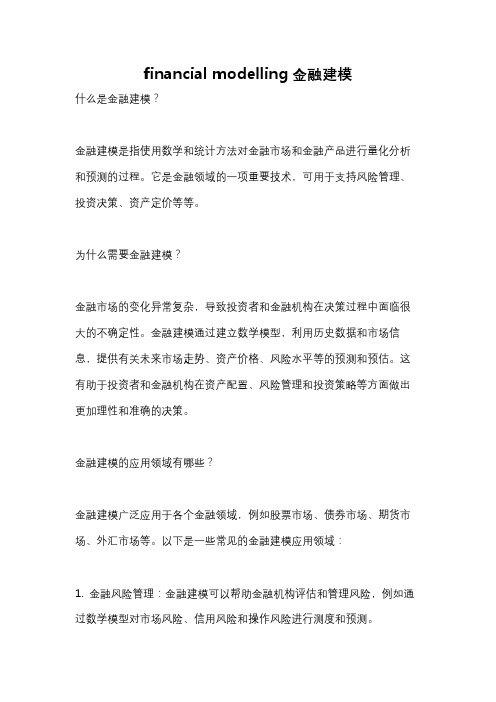
financial modelling金融建模什么是金融建模?金融建模是指使用数学和统计方法对金融市场和金融产品进行量化分析和预测的过程。
它是金融领域的一项重要技术,可用于支持风险管理、投资决策、资产定价等等。
为什么需要金融建模?金融市场的变化异常复杂,导致投资者和金融机构在决策过程中面临很大的不确定性。
金融建模通过建立数学模型,利用历史数据和市场信息,提供有关未来市场走势、资产价格、风险水平等的预测和预估。
这有助于投资者和金融机构在资产配置、风险管理和投资策略等方面做出更加理性和准确的决策。
金融建模的应用领域有哪些?金融建模广泛应用于各个金融领域,例如股票市场、债券市场、期货市场、外汇市场等。
以下是一些常见的金融建模应用领域:1. 金融风险管理:金融建模可以帮助金融机构评估和管理风险,例如通过数学模型对市场风险、信用风险和操作风险进行测度和预测。
2. 投资组合管理:金融建模可用于资产配置和投资组合管理,通过建立资产定价模型和风险模型,帮助投资者评估不同资产之间的相关性和风险水平,优化资产配置,以达到风险收益的最优化。
3. 衍生品定价:金融建模可以应用于衍生品的定价,例如期权、期货和利率互换等。
通过建立数学模型并使用市场数据,可以推导出衍生品定价的合理范围,为交易者提供参考价格。
4. 市场预测与交易策略:金融建模可以用于预测市场走势,例如股票价格、汇率变动等。
通过建立时间序列模型或机器学习算法,结合历史数据和市场信息,可以对未来市场走势进行预测,并基于预测结果制定交易策略。
如何进行金融建模?金融建模的过程包括以下几个步骤:1. 数据获取和清洗:首先需要获取和整理历史数据,例如市场价格、交易量、财务数据等。
然后对数据进行清洗和处理,以确保数据的完整性和准确性。
2. 模型选择:根据具体问题和数据特征,选择合适的建模方法和模型。
常用的金融建模方法包括回归分析、时间序列分析、蒙特卡洛模拟等。
3. 参数估计和模型验证:根据历史数据,对模型中的参数进行估计,并使用验证数据集检验模型的拟合效果和预测能力。
python在财务中的应用 教材
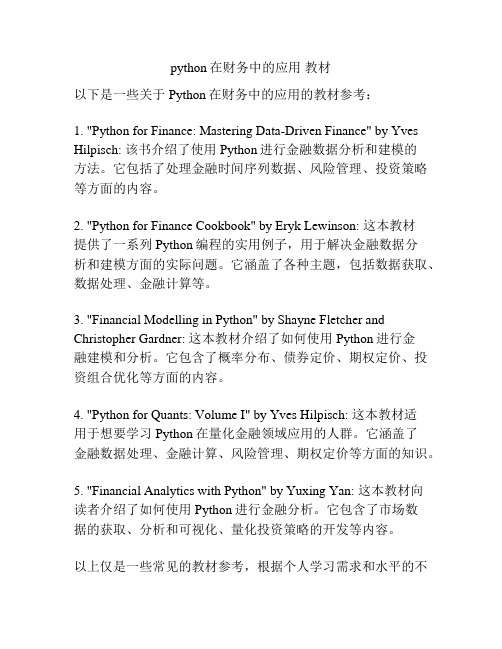
python在财务中的应用教材以下是一些关于Python在财务中的应用的教材参考:1. "Python for Finance: Mastering Data-Driven Finance" by Yves Hilpisch: 该书介绍了使用Python进行金融数据分析和建模的方法。
它包括了处理金融时间序列数据、风险管理、投资策略等方面的内容。
2. "Python for Finance Cookbook" by Eryk Lewinson: 这本教材提供了一系列Python编程的实用例子,用于解决金融数据分析和建模方面的实际问题。
它涵盖了各种主题,包括数据获取、数据处理、金融计算等。
3. "Financial Modelling in Python" by Shayne Fletcher and Christopher Gardner: 这本教材介绍了如何使用Python进行金融建模和分析。
它包含了概率分布、债券定价、期权定价、投资组合优化等方面的内容。
4. "Python for Quants: Volume I" by Yves Hilpisch: 这本教材适用于想要学习Python在量化金融领域应用的人群。
它涵盖了金融数据处理、金融计算、风险管理、期权定价等方面的知识。
5. "Financial Analytics with Python" by Yuxing Yan: 这本教材向读者介绍了如何使用Python进行金融分析。
它包含了市场数据的获取、分析和可视化、量化投资策略的开发等内容。
以上仅是一些常见的教材参考,根据个人学习需求和水平的不同,选择合适的教材将能够更好地学习Python在财务中的应用。
如何训练融资能力英语作文

如何训练融资能力英语作文题目,How to Train Financing Abilities。
In today's dynamic business environment, possessing strong financing abilities is crucial for individuals aiming to thrive in their careers. Whether one aspires to be an entrepreneur or climb the corporate ladder, the capacity to secure funding and manage financial resources effectively can make a significant difference. This essay explores various strategies to train and enhance financing abilities, drawing inspiration from successful practices and principles.First and foremost, developing a comprehensive understanding of financial concepts is fundamental. This involves grasping the principles of accounting, budgeting, and financial analysis. Engaging in courses or workshops that cover these topics can provide a solid foundation. Moreover, staying updated with current financial trends and market dynamics is essential. Subscribing to reputablefinancial publications, attending seminars, and following industry experts on social media platforms can offer valuable insights.Furthermore, practical experience plays a vital role in honing financing abilities. Actively seeking opportunities to manage finances, such as handling personal budgets or participating in financial projects at work, can provide invaluable hands-on experience. Additionally, volunteering for roles that involve financial responsibilities within community organizations or clubs can offer a platform to apply theoretical knowledge to real-world scenarios.Moreover, cultivating strong analytical skills is crucial for effective financial decision-making. This involves the ability to interpret financial data, identify trends, and make informed predictions. Engaging inactivities that require critical thinking, such as solving financial case studies or participating in investment simulations, can sharpen analytical abilities. Seeking feedback from mentors or peers can also provide valuable perspectives and help refine analytical capabilities.Another aspect of training financing abilities involves mastering communication and negotiation skills. Effective communication is essential for articulating financial proposals, presenting business plans to potential investors, and collaborating with financial stakeholders.Participating in public speaking events, joining debate clubs, or enrolling in communication courses can aid in developing persuasive communication skills. Likewise, practicing negotiation techniques through role-playing exercises or real-life scenarios can enhance the ability to secure favorable financial deals.In addition to technical skills, cultivating resilience and adaptability is crucial in the realm of finance. The financial landscape is prone to fluctuations and uncertainties, requiring individuals to navigate challenges with composure and flexibility. Engaging in activities that foster resilience, such as participating in high-pressure simulations or seeking feedback from setbacks, can build emotional strength and fortitude.Furthermore, fostering a mindset of continuous learning and improvement is essential for long-term success in financing. Embracing opportunities for professional development, pursuing certifications or advanced degrees in finance-related fields, and seeking mentorship from experienced professionals can facilitate ongoing growth and skill enhancement.In conclusion, training financing abilities is a multifaceted endeavor that requires a combination of theoretical knowledge, practical experience, analytical skills, communication proficiency, resilience, and a commitment to lifelong learning. By embracing these strategies and principles, individuals can cultivate the expertise and confidence needed to excel in the dynamic world of finance.。
- 1、下载文档前请自行甄别文档内容的完整性,平台不提供额外的编辑、内容补充、找答案等附加服务。
- 2、"仅部分预览"的文档,不可在线预览部分如存在完整性等问题,可反馈申请退款(可完整预览的文档不适用该条件!)。
- 3、如文档侵犯您的权益,请联系客服反馈,我们会尽快为您处理(人工客服工作时间:9:00-18:30)。
财务模型培训
今天的议题
财务预测模型介绍 工具与数据 构建简单的财务预测模型 构建复杂的财务预测模型
财务模型可以用来做什么? 财务模型可以用来做什么?
预算Budgeting 成本估算Cost Estimating 销售预测Sales Forecasting 销售预测 市场表现预测Market Share Forecasting 市场表现预测 投资项目的选择Project Selection & Management 投资项目的选择 业务/产品组合管理- 业务 产品组合管理-组合方案与优化 产品组合管理 实时的市场分析Time-to-Market Analysis 战略决策的评估Real Options Valuation 并购M & A
战略规划项目中的财务预测模型是什么?用来干什么? 战略规划项目中的财务预测模型是什么?用来干什么?
战略规划项目中的财务预测模型是 模拟各业务在不同运营策略/ 各业务在不同运营策略 模拟各业务在不同运营策略/业务模 式下及不同市场环境下各项业务的 式下及不同市场环境下各项业务的 大体财务表现及发展趋势。
因此, 大体财务表现及发展趋势。
因此,
在模拟业务表现时,先不考虑股权比 例、投资收益、少数股东权益等问 题;在最后并总表时,可以综合考虑 最后计数单位宜采用“千元”、“百 万元”等较大计量单位,切忌采用 元、角、分等极其精准的单位计量
财务预测模型绝对不能直接作为: 财务预测模型绝对不能直接作为: 直接作为
–
精准的预算 绩效考核的标准
–
但是,可以作为制定预算时的初步参 照,且其中部分有关运营方面的假设 项,例如产能利用率、损耗率等也可在 绩效考核中作为参照
在战略项目中, 财务预测模型将用于 在战略项目中,财务预测模型将用于 在战略项目中, 在战略项目中, 比较不同战略备选方案的经济价值 比较不同战略备选方案的经济价值 促进战略规划、行动方案的细化,并进行验证,反过来指导战略的制定 促进战略规划、行动方案的细化,并进行验证,反过来指导战略的制定 根据财务计划对未来进行资源安排提供依据 根据财务计划对未来进行资源安排提供依据
财务预测模型是以内外部业务发展/运营数据为基础, 财务预测模型是以内外部业务发展/运营数据为基础,模拟在不同业务 模式及市场环境下,各战略备选方案的经济价值… 模式及市场环境下,各战略备选方案的经济价值…
预测的数据来源
假如
预测的结果
业务模式
市场环境
内部历史财务数据 /运营数据 不同战略备选项的 财务表现 外部行业财务数据 /标竿运营数据 行业发展趋势数据
财务预测模型
确定最佳战略举措
修改分析框架 并假设关键参数的数值
不同行业适用的财务模型架构不同
制造/ 制造/服务类行业
– 此类行业的特点主要表现在产品/服务的销售是主要收入驱动 因素 – 这类行业可以通过对收入和费用的预测,预测利润
银行业
– 此类行业特点主要表现在收入并非是销售驱动的,利息是驱动 收入的主要因素 – 这类行业的收入是资产负债表驱动的,利润受利率的影响很大
以下主要针对制造/服务行业的财务模型构建方法进行介绍
衡量战略经济价值的常用财务预测数据时,最常比较的数据包括收入、 衡量战略经济价值的常用财务预测数据时,最常比较的数据包括收入、 利润、营运资金以及固定资产投资, 利润、营运资金以及固定资产投资,从而确定最佳战略举措
CEO视角
经常用于经济价值比较 经常用于经济价值比较 的财务预测数据… 的财务预测数据 的财务预测数据… 的财务预测数据
…从而确定最佳战略举 从而确定最佳战略举 …从而确定最佳战略举 从而确定最佳战略举 措 措
战略备选方案一 战略备选方案一
投资者视角
收入 收入 (Revenue) ) (Revenue) ) 战略备选方案一 未除利税前的净利润( EBIT) 未除利税前的净利润(EBIT) ) 未除利税前的净利润( 未除利税前的净利润( ) 净利润( Net Income) 净利润(Net Income) ) 净利润( 净利润( ) 营运资金 营运资金 (Working Capital) ) (Working Capital) ) 战略备选方案二 战略备选方案二 战略备选方案二 固定资产投资 固定资产投资 (CAPEX) ) (CAPEX) ) 其他 其他
NPV、进出口规模(Import & Export)、资产 NPV、进出口规模(Import & Export)、资产 规模(Total Asset)、资产回报率(ROE)… 规模(Total Asset)、资产回报率(ROE)…
CFO视角
衡量项目经济可行性常用的财务预测数据时,最常分析的指标包括: 衡量项目经济可行性常用的财务预测数据时,最常分析的指标包括:销 售利润率、 售利润率、IRR和NPV、投资回报期 和 、
CEO视角
• 投资的
销售利润率 IRR和NPV 和 投资规模 投资收益 投资回报期
可以通过EXCEL工具来建立财务模型 工具来建立财务模型 可以通过
全部通过Excel工 作表来实现 战略规划的财务模型
历史数据输入
核心预测驱动因素
预测结果和价值评估
输入历史上的损益 表、资产负债表、 现金流量表和其它 历史数据
输入预测的收入、 成本、资本性支出 及流动性追加等
输出预测的损益表、 资产负债表和现金流 量表 输入自由现金流量, 进行价值估算
输出 输入
今天的议题
财务预测模型介绍 工具与数据 构建简单的财务预测模型 构建复杂的财务预测模型
2.1 2.2调整
3.1 3.2
•Product by stage
•Manufactur er
ownership •Package type
•Share
•Store checks •Trade interviews
•Birth growth rate •Diary usage trend •Price trend
Consumer research
Cross-country comparison •Birth rate •Population •Geography •Income
•Age of baby •Usage behavior
•Statistics Bureau •Consumer research 驱动因素
数据来源。
